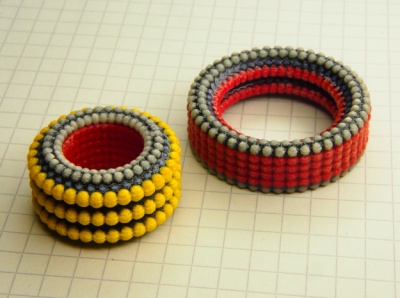Difference between revisions of "Superlubricity"
m (→Related) |
(→Related: added link to page: How friction diminishes at the nanoscale) |
||
| Line 50: | Line 50: | ||
* More [[friction]] due to [[rising surface area]]. | * More [[friction]] due to [[rising surface area]]. | ||
| + | * Less friction: [[How friction diminishes at the nanoscale]]. | ||
* ''Gem-like molecular elements'' or for short on this wiki here: ''[[crystolecule]]s'' | * ''Gem-like molecular elements'' or for short on this wiki here: ''[[crystolecule]]s'' | ||
* [[Superelasticity]] ... another performance parameter that can be unusually elevated at the nanoscale | * [[Superelasticity]] ... another performance parameter that can be unusually elevated at the nanoscale | ||
Revision as of 03:53, 23 August 2018

Up: Friction in gem-gum technology
Superlubricity (or superlubrication) is a state of extremely low friction that occurs when two atomically precise surfaces slide along each other in such a way that the "atomic bumps" do not mesh or more precisely when the lattices distances projected in the direction of movement are maximally incommensurate. It works at all (non destructive) temperatures includung 300K room temperature. Superlubricating bearings are generally wear free. Their dominating damage mechanism is ionizing radiation or thermal destruction.
The occurring friction is 2000 to 100000 times smaller than movement in water which is present e.g. in nanobiology. Note that diffusion transport by concentration gradients does not make biological systems more efficient. One expends the same free-energy cost as with any other way of driving motion. (see external links)
Examples exhibiting superlubrication:
- two coplanar sheets of graphene rotated to one another to minimally mesh
- two appropriately chosen tightly fitting coaxial nanotubes (experimantally demonstrated) (wiki-TODO: add reference)
- diamondoid molecular bearings and other DMEs with sliding interfaces.
- an advanced metamaterial forming an infinitesimal bearing structure.
If AP surfaces are designed or aligned to not mesh then the "perceived bumps" (the bumps that the surfaces perceive as a whole) become lower and their spacial frequency becomes higher (more bumps per length). If the surface pressure isn't extremely high the characteristic thermal energy kBT can become a lot higher than the bumps energy barriers. Thus the friction becomes so low that e.g. an unconstrained DMME bearing can be activated thermally and may starts turning randomly in a Brownian fashion [to verify].
Oxygen or sulfur with their two bonds in a plane parallel to the relative sliding direction are a good choice for surface termination of bearing interfaces since this configuration gives maximal stiffness in sliding direction.
If the two bonds of the atoms are instead in a plane normal to the sliding direction the lower stiffness may lead to higher energy dissipation (friction). Singly bonded hydrogen fluorine or chlorine passivations have even lower stiffness, see: E. Drexlers's blog: snap back dissipation. This can be deliberately used in dissipative elements (friction brakes). There's a critical point at which snapping back starts to occur [todo: simulation results needed].
Note that superlubrication is akin to superconuctivity only in name:
- Superlubrication is reached by decrease of degree of intermeshment while superconductivity is reached by decrease of temperature.
- There is not a sharp cutoff in friction when decreasing the dergree of intermeshment like the cutoff in superconductivity when decreasing temperature.
Contents
Main power dissipation mechanisms
(TODO: Integrate infos from Nanosystems and the "evaluating friction ..." paper.)
Snapping into place
As mentioned before there is always a slight remaining ripple in the position dependant potential energy of the bearing (in its potential energy surface - PES). This energy corresponds to the (very low) temperature under which the bearing starts to snap into place.
DM bearings
Interestingly Van der Waals forces allow for stable designs in which the axle in DM bearings is pulled outward in all directions instead of compressed inward allowing even lower friction. At high operation speeds resonant vibrations might occur though.
Quantum effects in DM bearings
Quantisation of angular momentum is usually not present except for very small free rotating elements at very low temperatures. Axels in nanomechanical systems are usually coupled to a bigger system making their moment of inertia rather big. Free rotations will often be suppressed which leaves only torsional vibrations as possible degree of freedom. See: Estimation of nanomechanical quantisation.
Related
- More friction due to rising surface area.
- Less friction: How friction diminishes at the nanoscale.
- Gem-like molecular elements or for short on this wiki here: crystolecules
- Superelasticity ... another performance parameter that can be unusually elevated at the nanoscale
- Superlubrication goes perfectly together with infinitesimal bearings, reducing friction even further.
External links
Related pages on E. Drexlers homepage:
- Phonon drag in sleeve bearings can be orders of magnitude smaller than viscous drag in liquids
- Symmetric molecular bearings can exhibit low energy barriers that are insensitive to details of the potential energy function
- Stiffly supported sliding atoms have a smooth interaction potential
- Softly supported sliding atoms can undergo abrupt transitions in energy
- Paper: "Evaluating the Friction of Rotary Joints in Molecular Machines" (2017-01-27)
arXiv:1701.08202 [cond-mat.soft]; ResearchGate; pubs.rsc.org; Google Scholar
This uses simpified results from the Fluctuation-dissipation_theorem (Wikipedia-link)
- Wikipedia: Superlubricity
- Experiments with nanotubes: Superlubricity on the macroscale